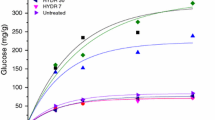Abstract
Lime (calcium hydroxide) was used as a pretreatment agent to enhance the enzymatic digestibility of two common crop residues: bagasse and wheat straw. A systematic study of pretreatment conditions suggested that for short pretreatment times (1–3 h), high temperatures (85-135°C) were required to achieve high sugar yields, whereas for long pretreatment times (e.g., 24 h), low temperatures (50–65°C) were effective. The recommended lime loading is 0.1 g Ca(OH)2/g dry biomass. Water loading had little effect on the digestibility. Under the recommended conditions, the 3-d reducing sugar yield of the pretreated bagasse increased from 153 to 659 mg Eq glucose/g dry biomass, and that of the pretreated wheat straw increased from 65 to 650 mg Eq glucose/g dry biomass. A material balance study on bagasse showed that the biomass yield after lime pretreatment is 93.6%. No glucan or xylan was removed from bagasse by the pretreatment, whereas 14% of lignin became solubilized. A lime recovery study showed that 86% of added calcium was removed from the pretreated bagasse by ten washings and could be recovered by carbonating the wash water with CO2 at pH 9.5.
Similar content being viewed by others
References
Ernest, R. K. and Buffington, L. E. (1981), inCRC Handbook of Biomass Resources, vol. II. Zaborsky O. R., ed., CRC., Boca Raton, FL, pp. 501–509.
Day, D. L. (1989), inBiomass Handbook, Kitani, O. and Hall, C. W., eds. Gordon and Breach Science Publishers, New York, pp. 142–146.
Fan, L. T., Lee, Y.-H., and Gharpuray, M. M. (1982),Adv. Biochem. Eng. 23, 157–187.
Kong, R., Engler, C. R. and Soltes, E. J. (1992),Appl. Biochem. Biotechnol. 34, 23–35.
Han, Y. W., Catalano, E. A., and Ciegler, A. (1983), inWood and Agricultural Residues: Research on Use for Feed, Fuels, and Chemicals, Soltes, J., ed. Academic, New York, pp. 217–238.
Fontana, J. D., Ramos, L. P., and Deschamps, F. C. (1995),Appl. Biochem. Biotechnol. 51/52, 105–116.
Deschamps, F. C., Ramos, L. P., and Fontana, J. D. (1996),Appl. Biochem. Biotechnol. 57/58, 171–182.
van Walsum, G. P., Allen, S. G., Spencer, M. J., Laser, M. S., Antal, M. J., and Lynd, L. R. (1996),Appl. Biochem. Biotechnol. 57/58, 157–170.
Ibrahim, M. N. M. and Pearce, G. R. (1983),Agricultural Wastes 5, 135–156.
Playne, M. J. (1984),Biotechnol. Bioeng. 26, 426–433.
Ladisch, M. R., Ladisch, C. M., and Tsao, G. T. (1978),Science 201, 743–745.
Holtzapple, M. T., Jun, J.-H., Ashok, G., Patibandla, S. L., and Dale, B. E. (1991),Appl. Biochem. Biotechnol. 28/29, 59–74.
Gharpuray, M. M., Lee, Y.-H., and Fan, L. T. (1983),Biotechnol. Bioeng. 25, 157–172.
Fan, L. T., Gharpuray, M. M., and Lee, Y.-H. (1981),Biotechnol. Bioeng. Symp. 11, 29–45.
Beltrame, P. L., Carniti, P., and Visciglio, A. (1992),Bioresource Technol. 39, 165–171.
Wilson, R. K. and Pigden, W. J. (1964),Can. J. Anim. Sci. 44, 122–123.
Verma, M. L. (1983), inThe Utilisation of Fibrous Agricultural Residues, Pearce, G. R., ed. Australian Government Publishing Service, Canberra, A.C.T., pp. 85–99.
Djajanegara, A., Molina, B. T., and Doyle, P. T. (1984),Anim. Feed Sci. Technol. 12, 141–150.
Lesoing, G., Klopfenstein, T., Rush, I., and Ward, J. (1981),J. Anim. Sci. 51, no. 2, 263–269.
Detroy, R. W., Lindenfelser, L. A., St. Julian, G., Jr., and Orton, W. L. (1980),Biotechnol. Bioeng. Symp. 10, 135–148.
Grohmann, K., Torget, R., and Himmel, M. (1985),Biotechnol. Bioeng. Symp. 15, 59–80.
Holtzapple, M. T. (1981), inThe Pretreatment and Enzymatic Saccharification of Poplar Wood, Ph.D. Dissertation, University of Pennsylvania, Philadelphia, PA, pp. 1–47.
Chemical Marketing Reporter251(3), January 20, 1997, Schnell Publishing, New York, pp. 22–30.
Chang, V. S., Burr, B., and Holtzapple, M. T. (1997), Lime pretreatment of switchgrass.Appl. Biochem. Biotechnol,63–65, 3–19.
Chemical Analysis & Testing Standard Procedure, no. 002–006, National Renewable Energy Laboratory, Golden, CO.
Miller, G. L. (1959),Anal. Chem. 31, 462–428.
Chang, V. S., Holtzapple, M. T., and Davidson, R. (1996), inDevelopment of Alternative Pretreatment and Biomass Fractionation Processes: Lime Pretreatment, part III, Final Report, Subcontract XAW-3-11181-03, National Renewable Energy Laboratory, Golden, CO, pp. 28–30.
Author information
Authors and Affiliations
Corresponding author
Rights and permissions
About this article
Cite this article
Chang, V.S., Nagwani, M. & Holtzapple, M.T. Lime pretreatment of crop residues bagasse and wheat straw. Appl Biochem Biotechnol 74, 135–159 (1998). https://doi.org/10.1007/BF02825962
Issue Date:
DOI: https://doi.org/10.1007/BF02825962




